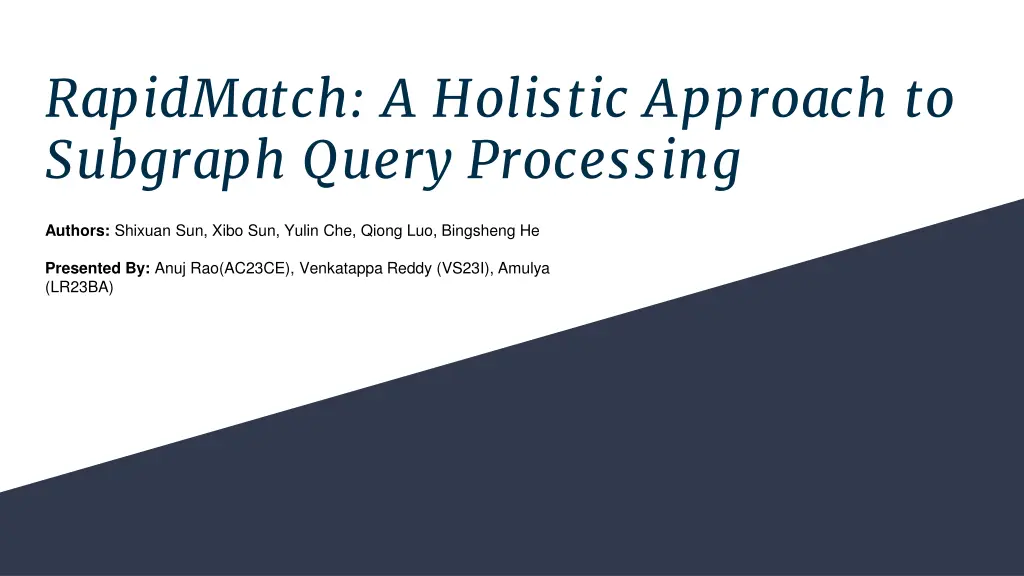
Innovative Subgraph Query Processing in Graph Analytics
Explore RapidMatch, a holistic approach to subgraph query processing in graph analytics, presenting a unified solution for queries of any size. Discover the challenges in existing exploration-based and join-based methods, and learn about the key innovations and architecture that make RapidMatch efficient and scalable.
Download Presentation

Please find below an Image/Link to download the presentation.
The content on the website is provided AS IS for your information and personal use only. It may not be sold, licensed, or shared on other websites without obtaining consent from the author. If you encounter any issues during the download, it is possible that the publisher has removed the file from their server.
You are allowed to download the files provided on this website for personal or commercial use, subject to the condition that they are used lawfully. All files are the property of their respective owners.
The content on the website is provided AS IS for your information and personal use only. It may not be sold, licensed, or shared on other websites without obtaining consent from the author.
E N D
Presentation Transcript
RapidMatch: A Holistic Approach to Subgraph Query Processing Authors: Shixuan Sun, Xibo Sun, Yulin Che, Qiong Luo, Bingsheng He Presented By: Anuj Rao(AC23CE), Venkatappa Reddy (VS23I), Amulya (LR23BA)
Problem & Motivation Subgraph Query processing plays crucial role in graph analytics with applications like Fraud Detection and Bioinformatics. Most Existing methods are either exploration based or join based. Exploration based and Join based systems have complementary strengths. Existing techniques specialize either in small queries or large queries, but not both. A unified solution that s fast, scalable, and effective for any query size.
Existing Methods Exploration Based Algorithms: CLF-Match, DP-iso Good at handling large query graphs. Poor enumeration efficiency for small queries Join Based Algorithms: EmptyHeaded, Graphflow Optimal for smaller query graphs. Struggles with large query graphs due to exponential join plan space.
Key Innovation A join based engine with Graph exploration capabilities. Small Queries: Uses WCOJ (Worst-Case Optimal Join) for low- cost, scalable enumeration. Applies intersection caching and trie encoding to minimize overhead. Large Queries: Applies graph-based pruning using semi-joins to eliminate false candidates early. Uses nucleus decomposition to guide join plan through dense query regions.
Architecture Overview Relation Filter: Prunes data with semi-joins. Join Plan Generator: Uses nucleus forests to optimize execution order. Relation Encoder: Organizes data into efficient formats. Result Enumerator: Executes optimized joins with caching and pruning.
Selection - L(u1) = L(v1) and L(u1 ) = L(v1 ) Semi Join Operation R(u , u ) = R(u , u ) R(u , u ) R(u , u )
Failing set pruning -Avoid recomputing paths that already failed before. Intersection on Caching -Reuse results of set intersections that are computed. Set Intersection -Efficiently compute common neighbors using min property.
Performance Comparison |E(Q)| -Number of edges in Query graph |E(G)| -Number of edges in Data graph |V(Q)| -Number of vertices in Query graph
Performance Comparison Dataset Query Performance of Large Queries Performance of Small Queries
Results & Analysis Key Findings: Up to 3x speedup over prior methods on mixed workloads Efficient for both small and large queries. Scalable to millions of edges. Why: Filters early (prunes large amounts). Avoids materializing large intermediate results. Adjusts execution based on query size and density.
Conclusion RapidMatch bridges the gap between exploration and join-based methods. Efficient for all query sizes with graph-aware join plan generation Future work may extend to: Dynamic graphs Edge-labeled or directed graphs
